Filling the Gap: AMOLED and LCD from 2010 to 2012
by Joshua Ho on July 26, 2014 6:00 AM EST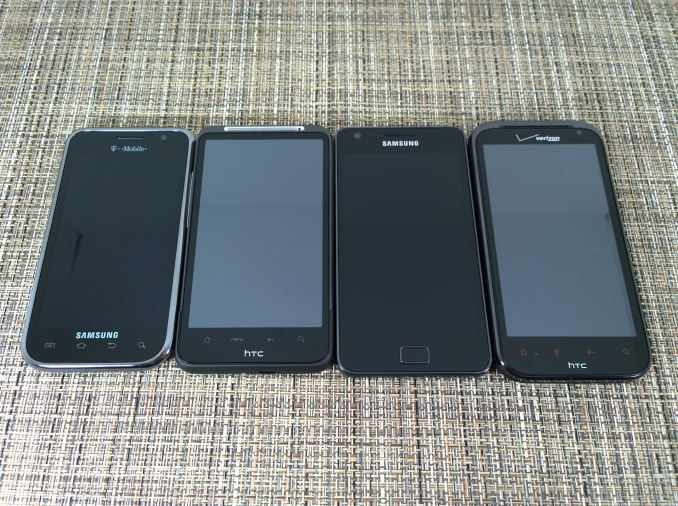
Introduction
For a while now, I’ve realized that there is a massive gap in the continuity of smartphone display history. Until the last few months of 2011 or early 2012, proper testing of smartphone displays was few and far between. Most websites tested peak brightness and contrast, and possibly white point. While some websites did go in depth, they would often only test a few phones. Of course, now things are different. Websites are starting to scrutinize display quality from all angles from color accuracy to reflectance, but no one has ever gone back to properly test old devices.
Of course, the best time to have tested these old devices was when they were new. The next best time is now, so let’s get to it. Unfortunately in the span of 4 years it’s become rather difficult to find all the devices that I’d like, but we’ll look at some of the key representative devices of each generation. This means the Galaxy S, Desire HD, Galaxy S2, and Rezound. The first three are all WVGA, 800x480 resolution displays. The Galaxy S has a 4 inch display, and all the other devices have a 4.3” display. All of them are also easily used with one hand, which is almost a surprise these days. Unfortunately, battery life testing won't be possible as all of the devices have aged too much for the results to be representative of their actual performance. As always, in order to properly test displays we use a custom workflow on SpectraCal's CalMAN 5.
Samsung Galaxy S
For most people, the Galaxy S would be their first encounter with Samsung’s SAMOLED displays and PenTile layouts. While it may have been acceptable at some point in the past, it’s quite obvious that this display hasn’t aged well at all. While high pixel density masks the effects of PenTile quite well, they’re omnipresent in the original Galaxy S. Even at relatively far distances from the display I can make out gaps between pixels in text. At the edges, there’s a strange effect where the lines are clearly not straight. Instead, the edges of text appear to be quite rough, making a zig zag pattern instead of a clean line.
Putting aside PenTile, the brightness of this display has aged relatively well. The expected brightness seems to be about 350 nits out of the box, and the T-Mobile unit I tested seemed to have lost some of its peak brightness, but it’s still quite bright at around 320 nits. Contrast is great as always here.
Grayscale is where things get ugly. Red is effectively no longer visible in the graph by 35% white, and both green and blue are completely out of control. The result is one of the worst averages for dE2000 error I’ve ever recorded.
In the saturation sweep, we see a similar story. Just about every type of mistake in color accuracy is seen here. Extreme blue/green shift on white, saturation compression, gamut far out of sRGB, hue shifts with saturation changes, and no way to improve it.
As expected, a similar result is seen in the Gretag Macbeth ColorChecker. This is simply a logical extension of poor color control in the saturations test, so this is no surprise. Looking at the Galaxy S5 LTE-A, it’s definitely incredible to see just how far Samsung has come since the early days of AMOLED technology.



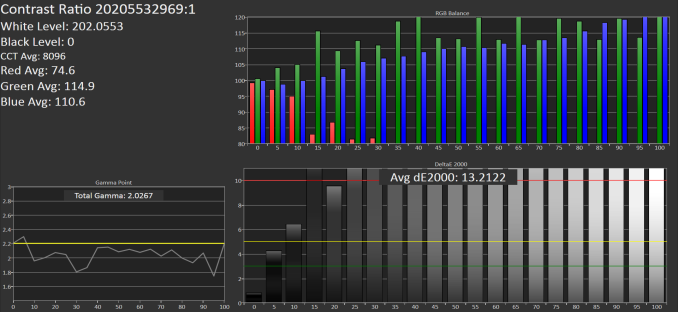
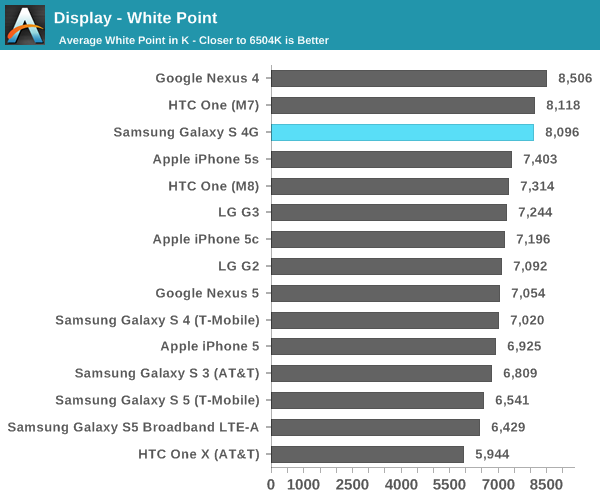
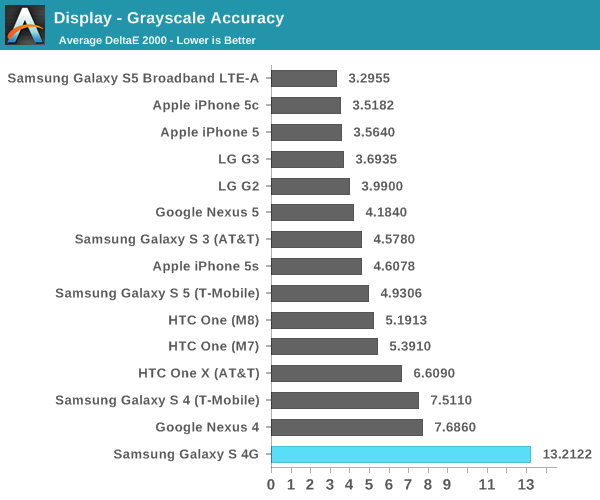

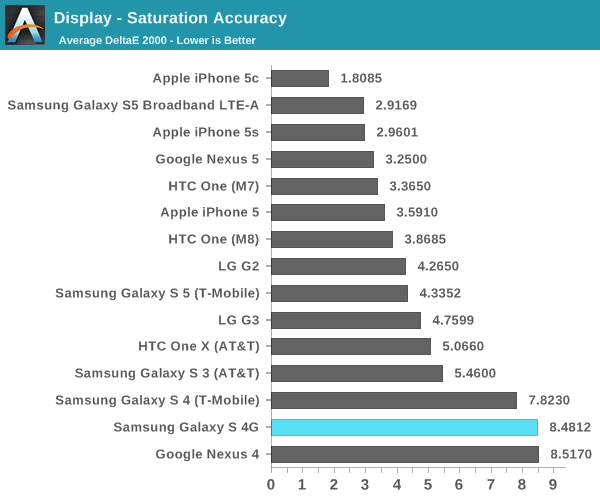
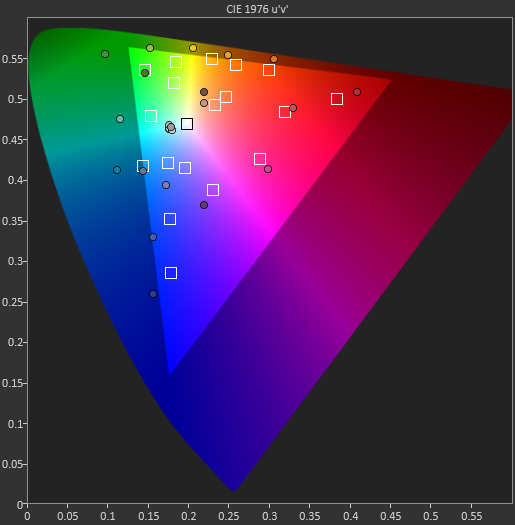
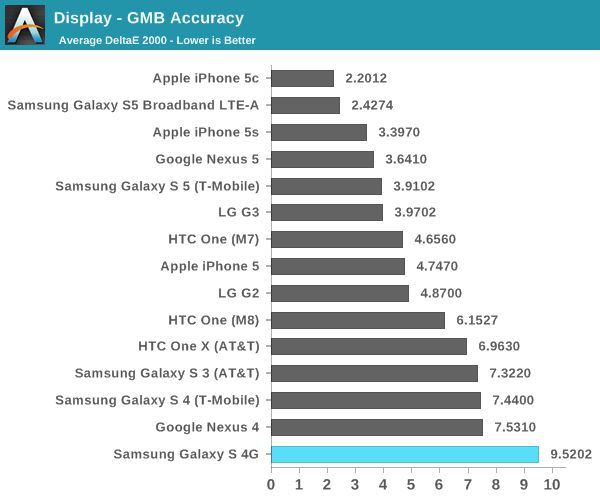








72 Comments
View All Comments
Impulses - Saturday, July 26, 2014 - link
Yeah, photography is the one big reason it matters in phones IMO, and not because I'd print straight from phone or wanna edit content on my phone... Trivial yet very practical endeavors like buying stuff online or even sharing stuff requires some degree of accuracy.I was renting a tux for a wedding where I was best man and the bride wanted my tie/handkerchief to match the bridesmaid's... I ended up bringing my camera for something that should've been wholly unnecessary (taking a handful of pictures of neck tie colors) because between my phone's camera and display I'd have little control over what she'd end up seeing...
Even then I had no control over her own display but I know they have a recent iPad so... Figured that'd be close enough.
Alexey291 - Saturday, July 26, 2014 - link
Yeah except you see there's a simple issue of - you take the photos with a camera on a phone. You expect them to be piss poor. (Sorry for the lingua but its true - there's not a single smartphone out there that actually takes good quality photos compared to a dedicated camera). Some phones are better than others but the tiny lens simply ruins colours and light.If you actually cared about how people would perceive your photos you would take them through a photo editor on a computer with a decent screen (and use a dedicated camera for god's sake). Most never bother. But even if one does the point is still moot because most people have their screens/monitors/phones all configured differently. Despite this one single website's (yours) crusade for standardisation :)
But I don't exactly expect you to stop posting these reviews. Though I do find this blast from the past a little odd considering how many reviews you have pending currently :P
Streamlined - Saturday, July 26, 2014 - link
This isn't 2002 anymore. The best camera is the one you got and for most people that is their phone. And if people really wanted quality pictures only from a dedicated camera than someone forgot to tell Nokia, Apple and Samsung.jwcalla - Saturday, July 26, 2014 - link
The point still stands though. The color accuracy of the display is hardly relevant when dealing with photos taken from a smartphone camera. In that case the weakest link in the color accuracy chain is, by far, the camera.AnnonymousCoward - Monday, July 28, 2014 - link
"Weakest link" arguments often don't make sense. Inaccuracies are additive. A good display is always beneficial. Furthermore, don't you think websites you visit on your phone have pictures taken with DSLRs?Alexey291 - Sunday, July 27, 2014 - link
you'll find that good pictures you see on your FB/G+ stream ARE in fact taken from a dedicated camera, usually with a stand and separate flash (if need be) as well.And then there's the stuff people with smartphones take. Which might as well be viewed on tiny smartphone screens - at least there it MAY look passable.
mkozakewich - Sunday, July 27, 2014 - link
"If you actually cared about how people would perceive your photos you would take them through a photo editor on a computer with a decent screen..."That's the whole point! If your phone is a computer with a decent screen, you can edit your photos.
Your argument is generally that today's phones don't make good production environments. The fix for that is to identify why, and improve them. Better apps, better screens, better processors, better interfacing (keyboards/mice), and then there's no reason you can't just edit photos on it.
If I were editing photos, I'd prefer to look at them on an iPhone 5 (or better, an iPad Air) than on my current computer screen.
Alexey291 - Sunday, July 27, 2014 - link
Well they don't make good production (for photography at least) environments because the camera is bad.Very little can be done to fix that due to lens size in the smartphone. The screen is just a small factor in the equation.
bill5 - Tuesday, July 29, 2014 - link
yeah i dunno, the color accuracy thing just seems like another big phone media way to bash samsung/praise appleakdj - Saturday, August 9, 2014 - link
So apparently you've. It read the past year's worth of Samsung and Apple reviews? The measurements of AMOLED in 13/14 vs 11/12? I'm not sure you're actually comprehending the actual article. At all